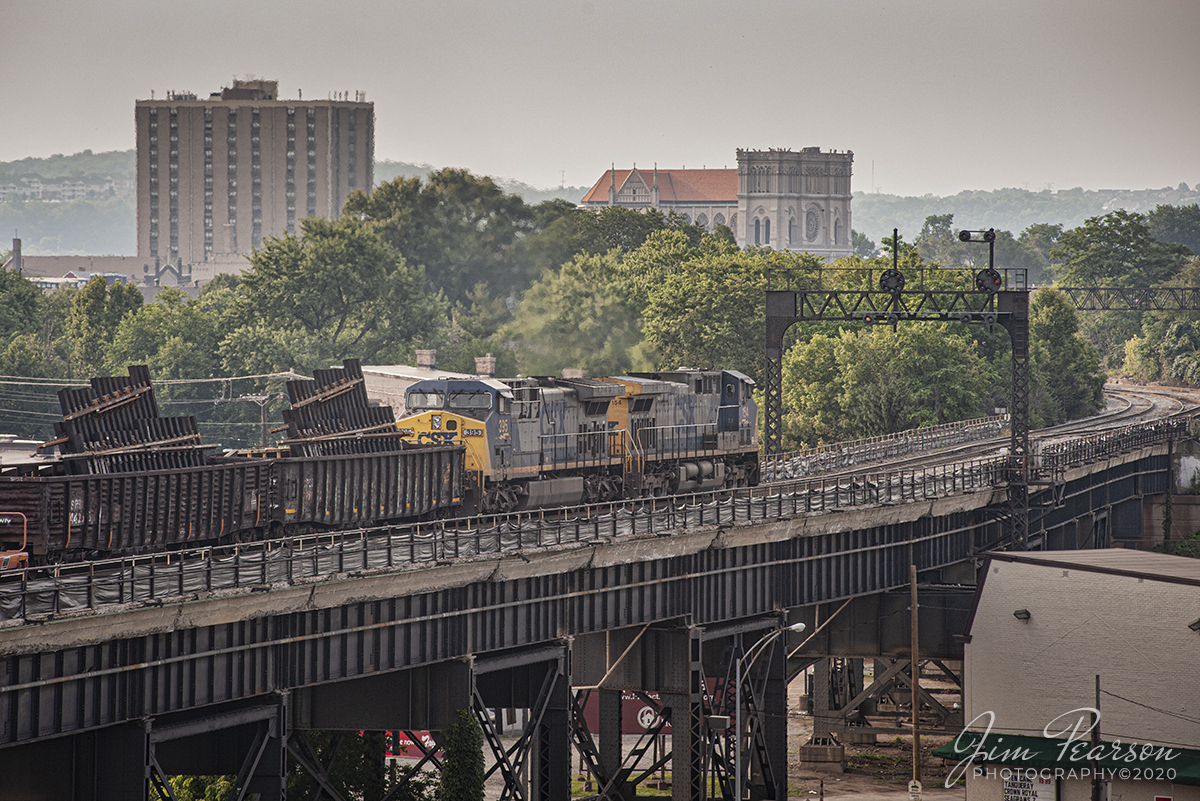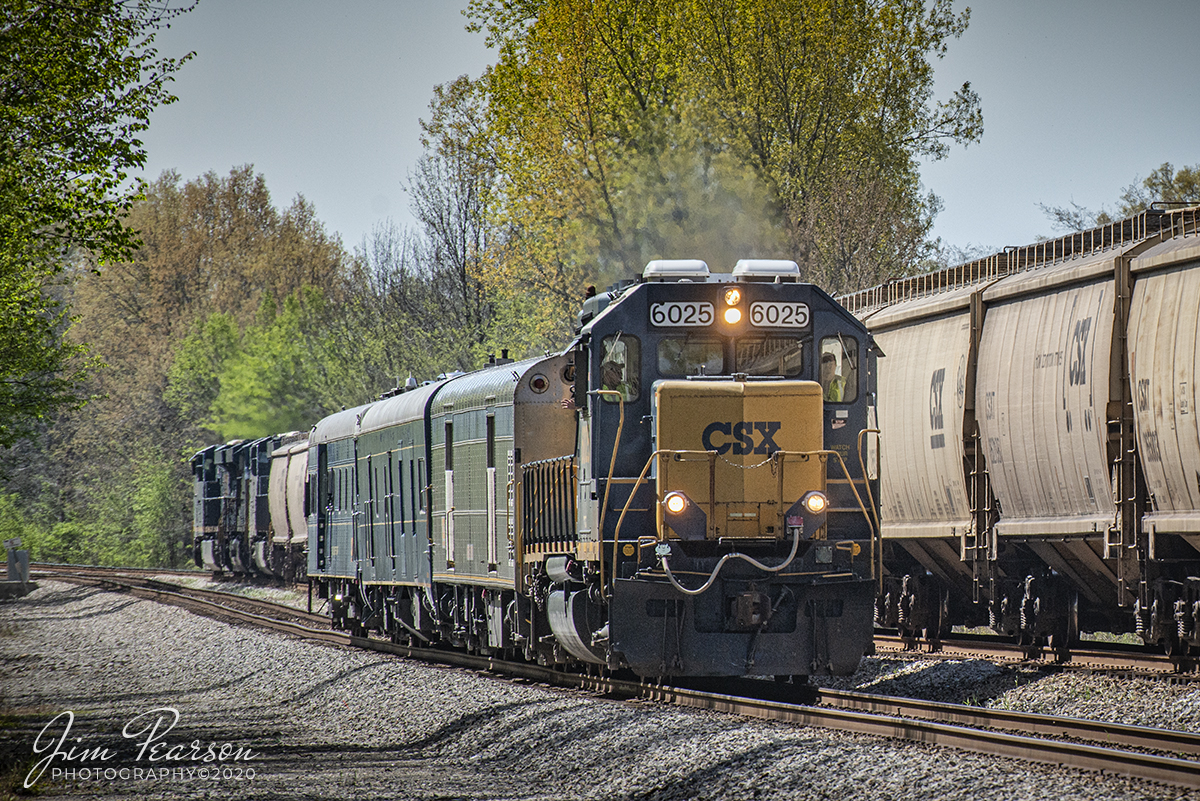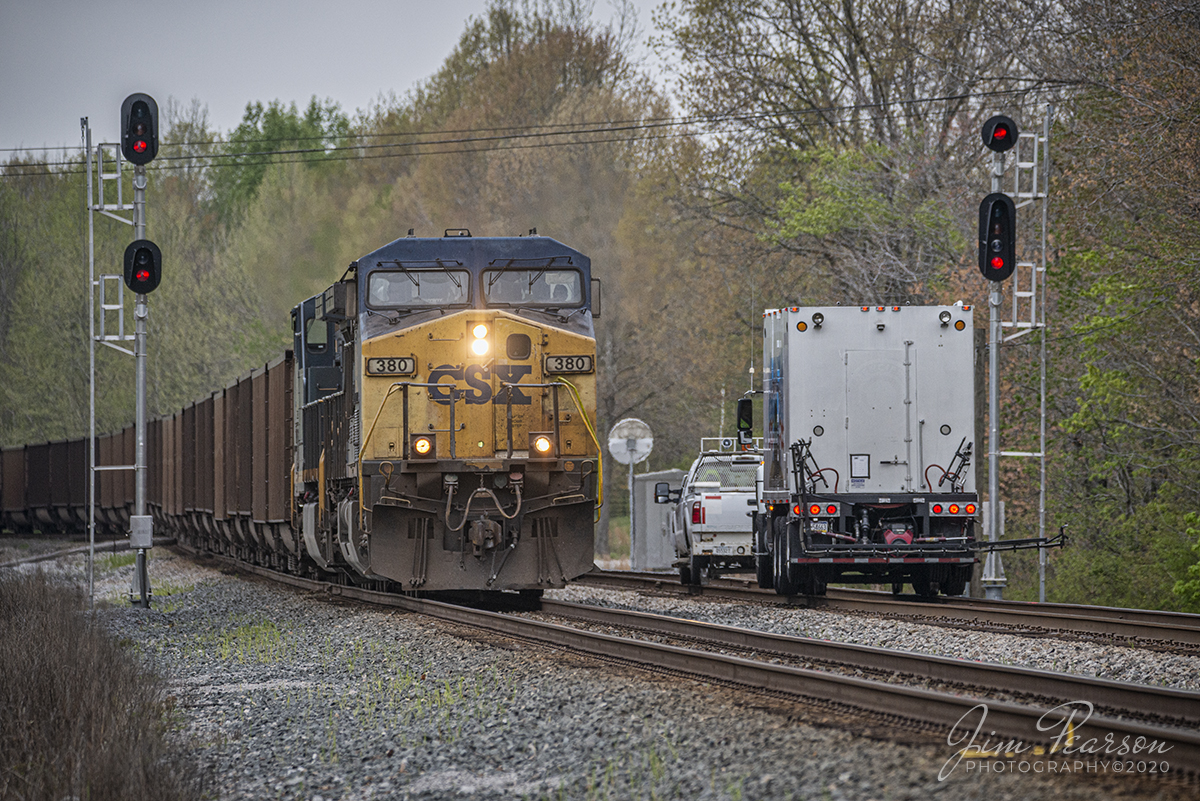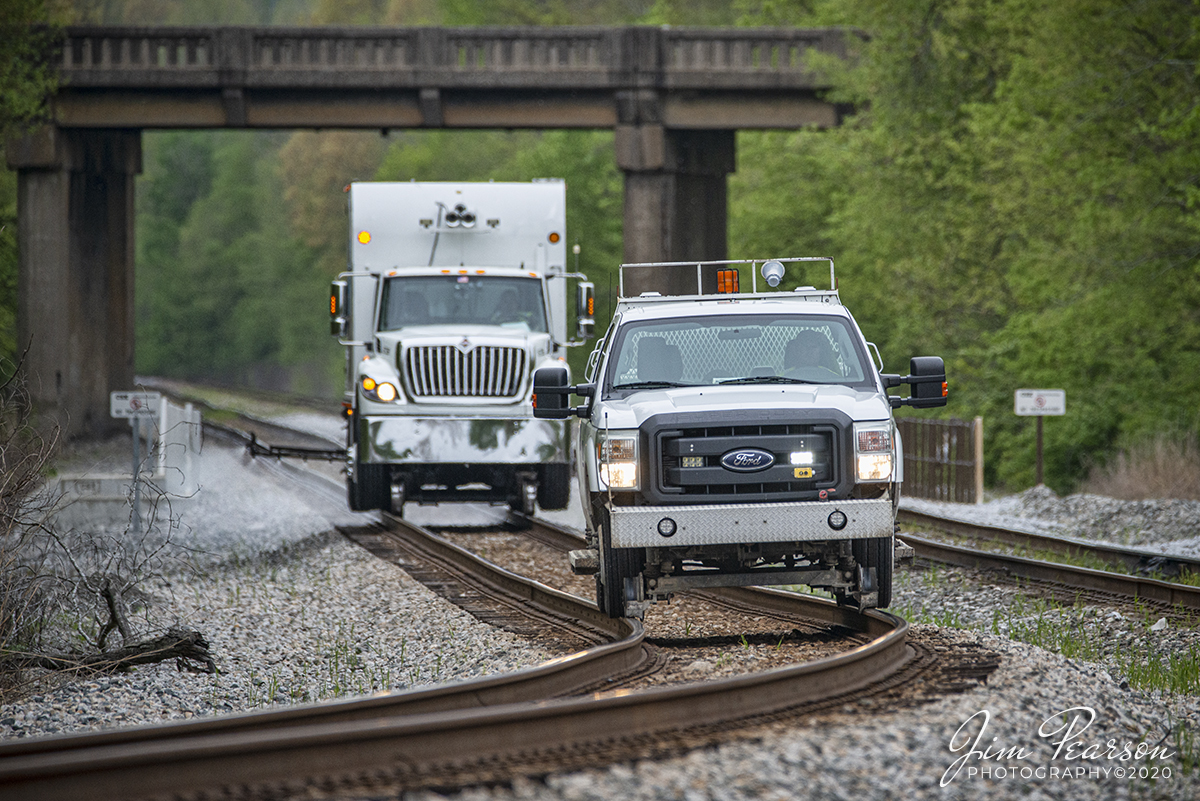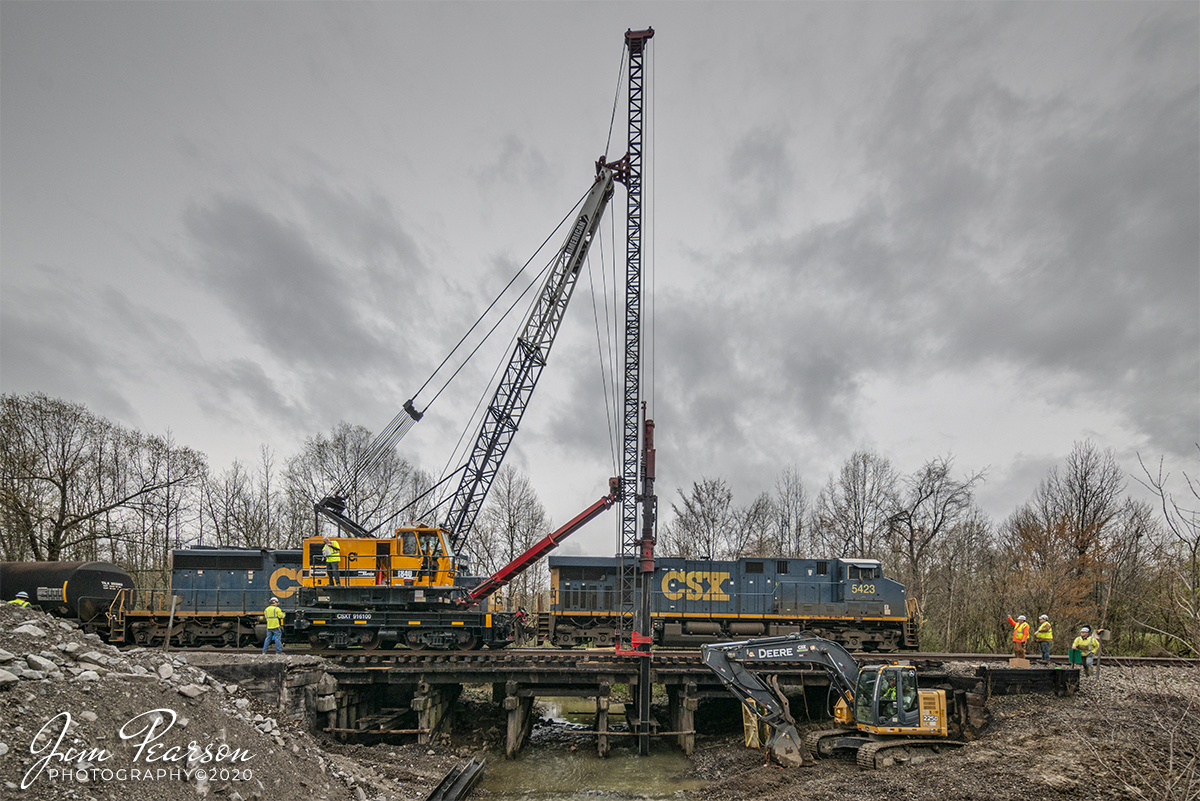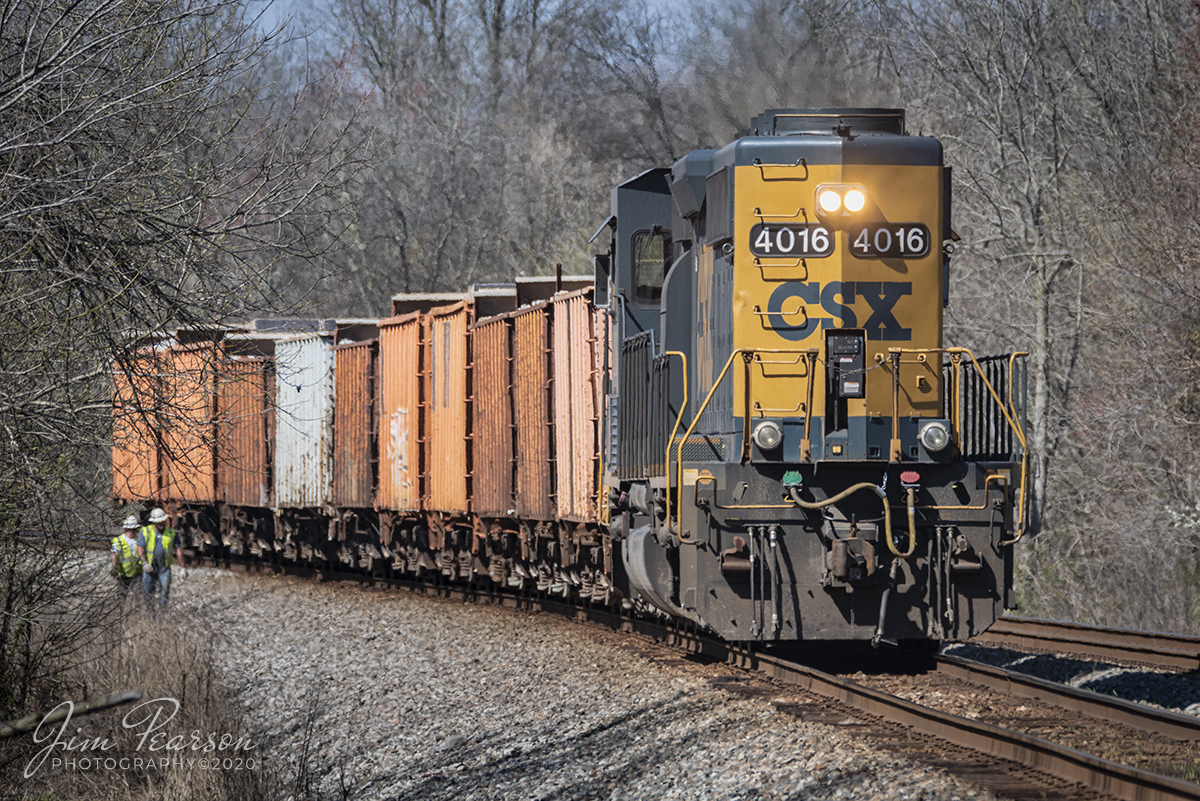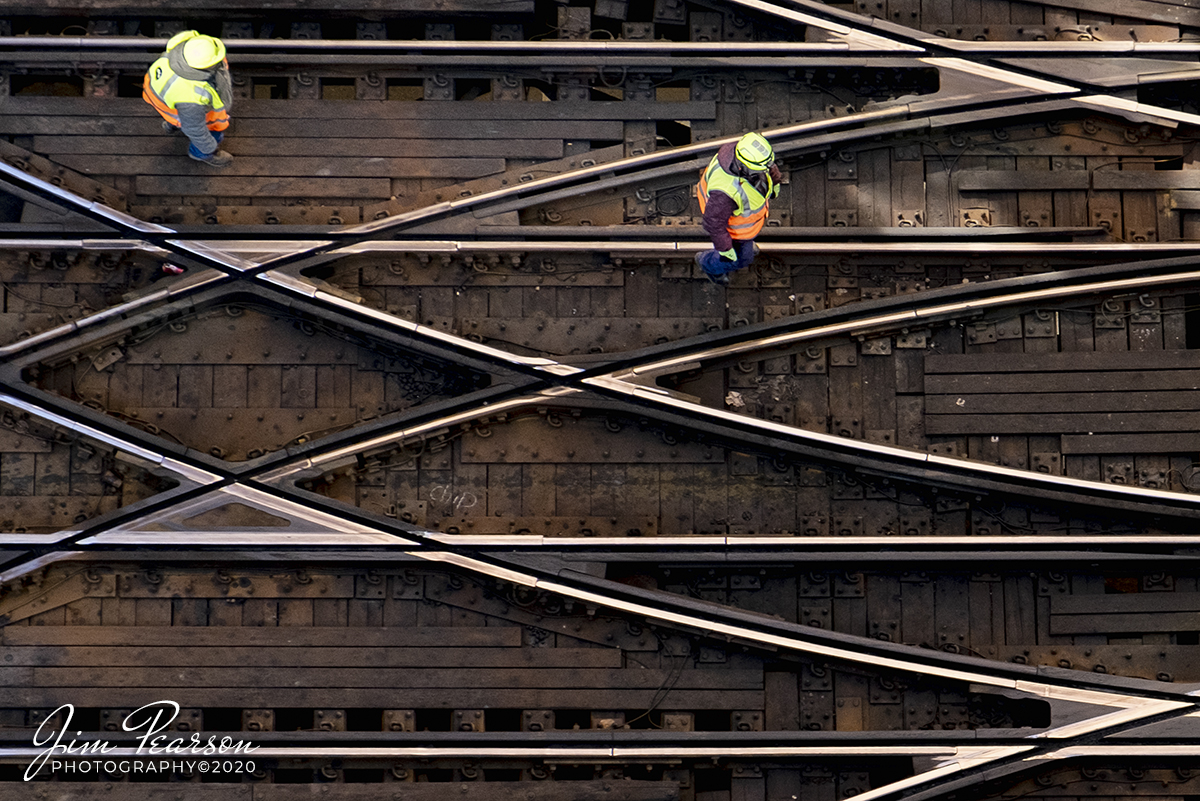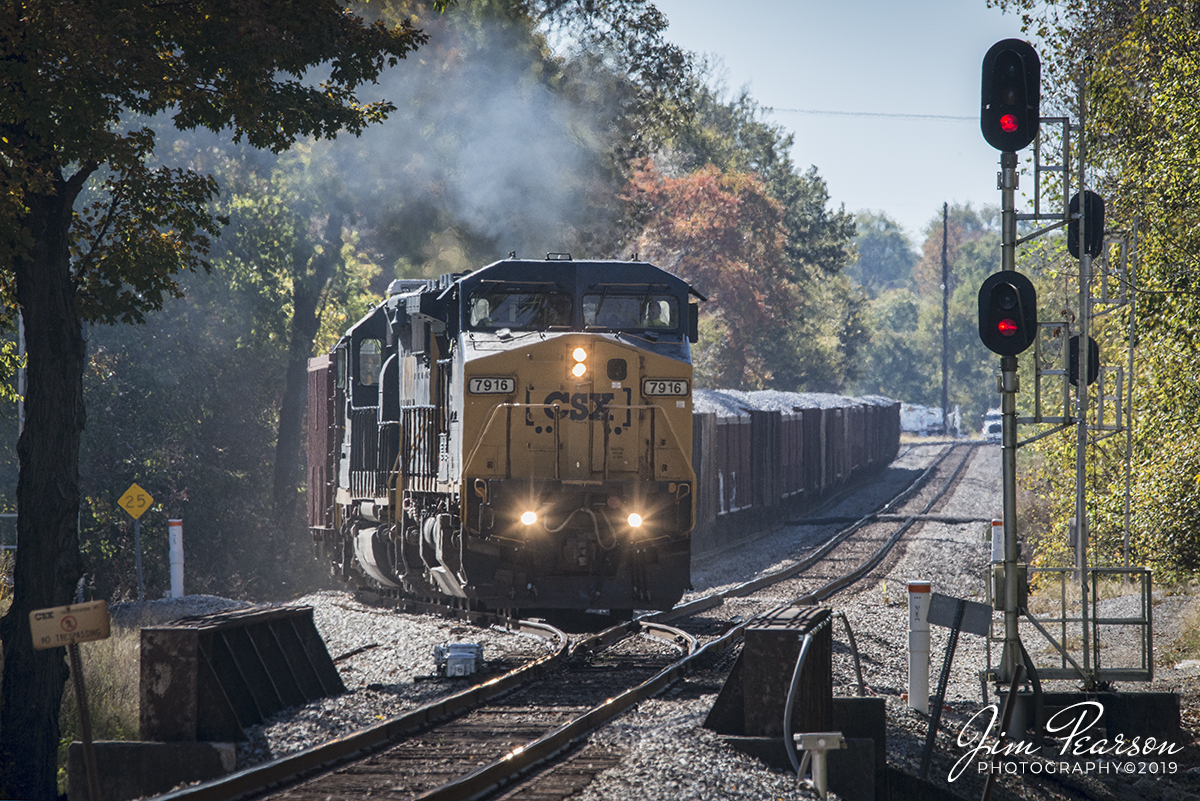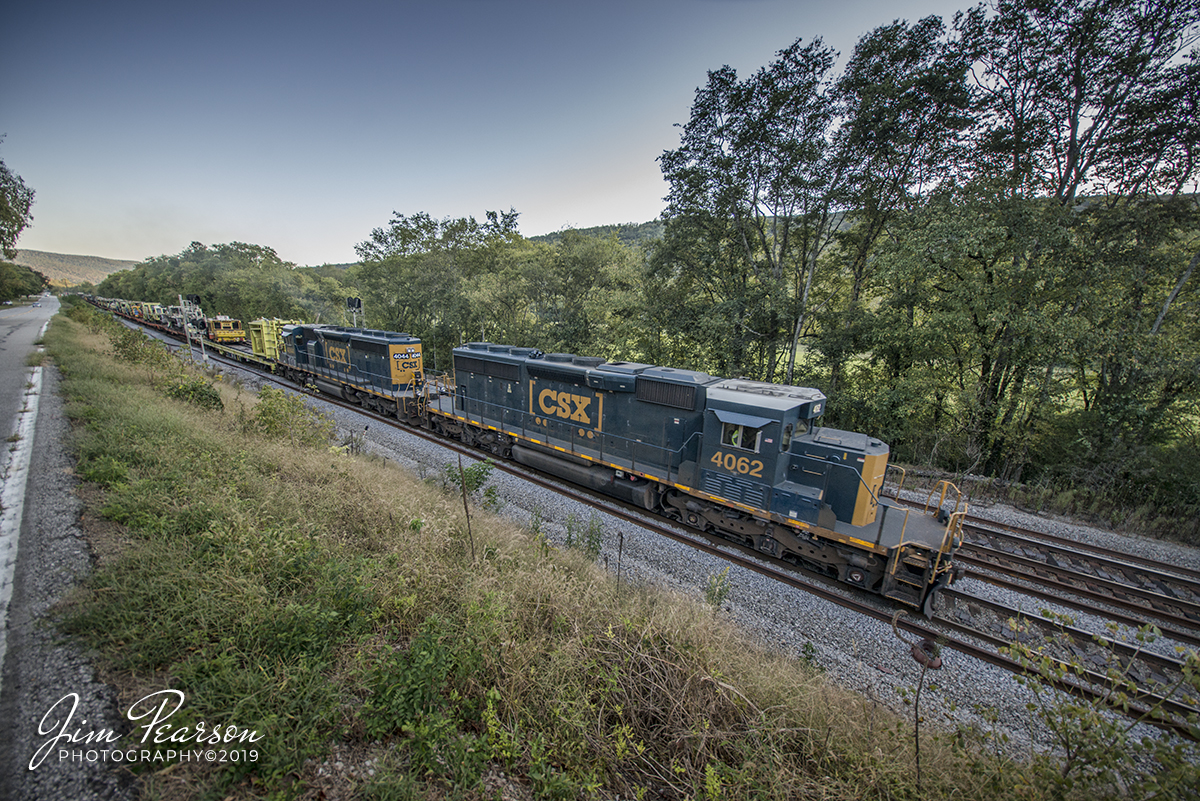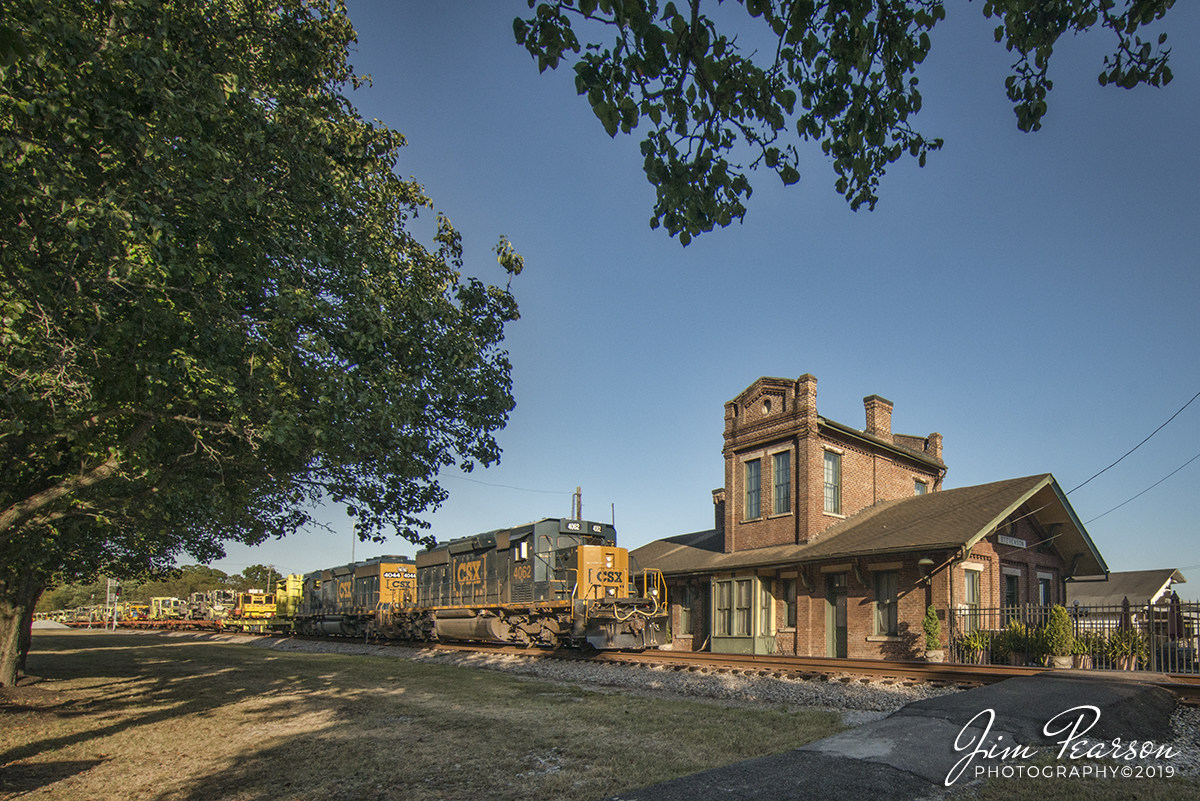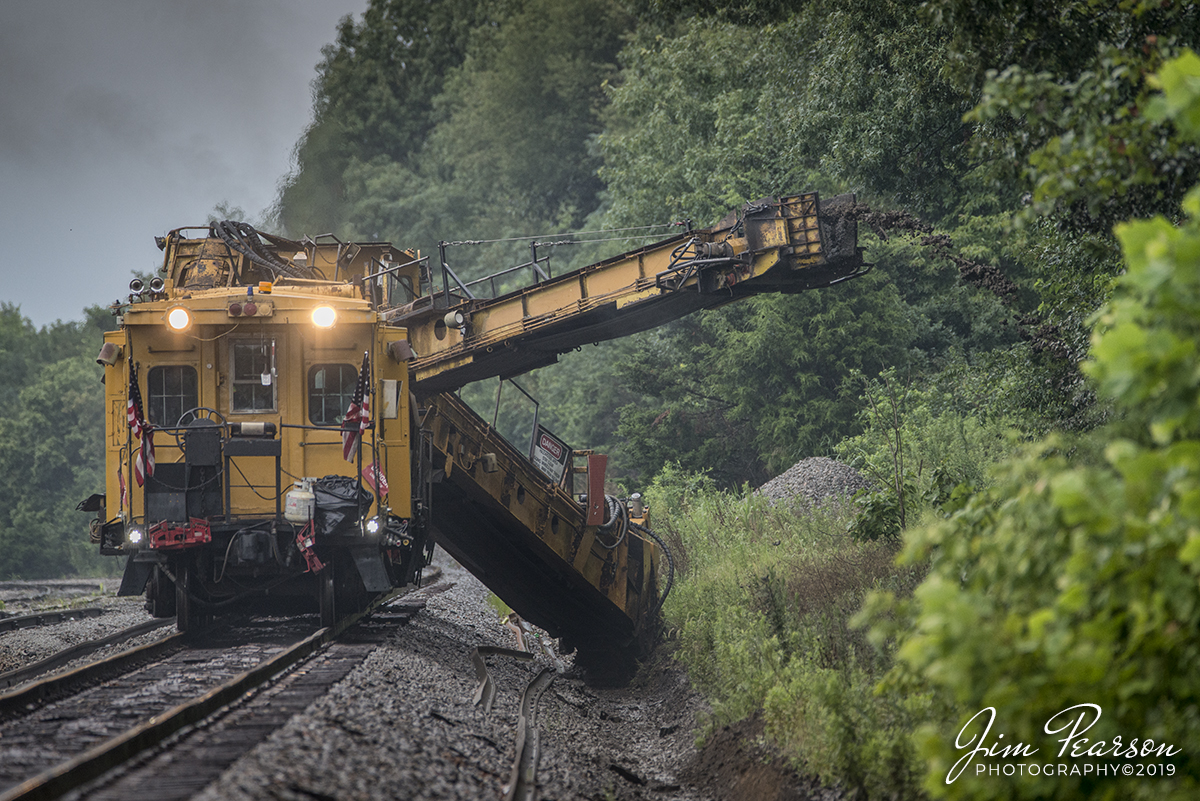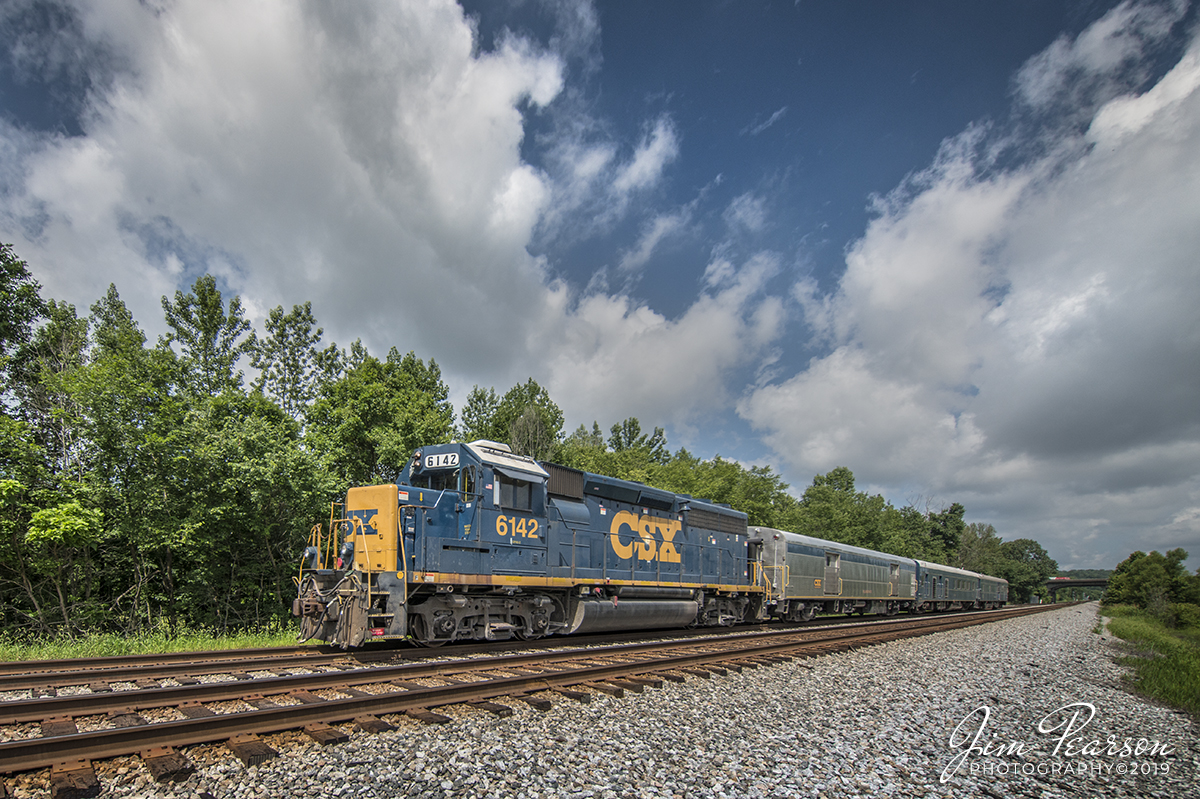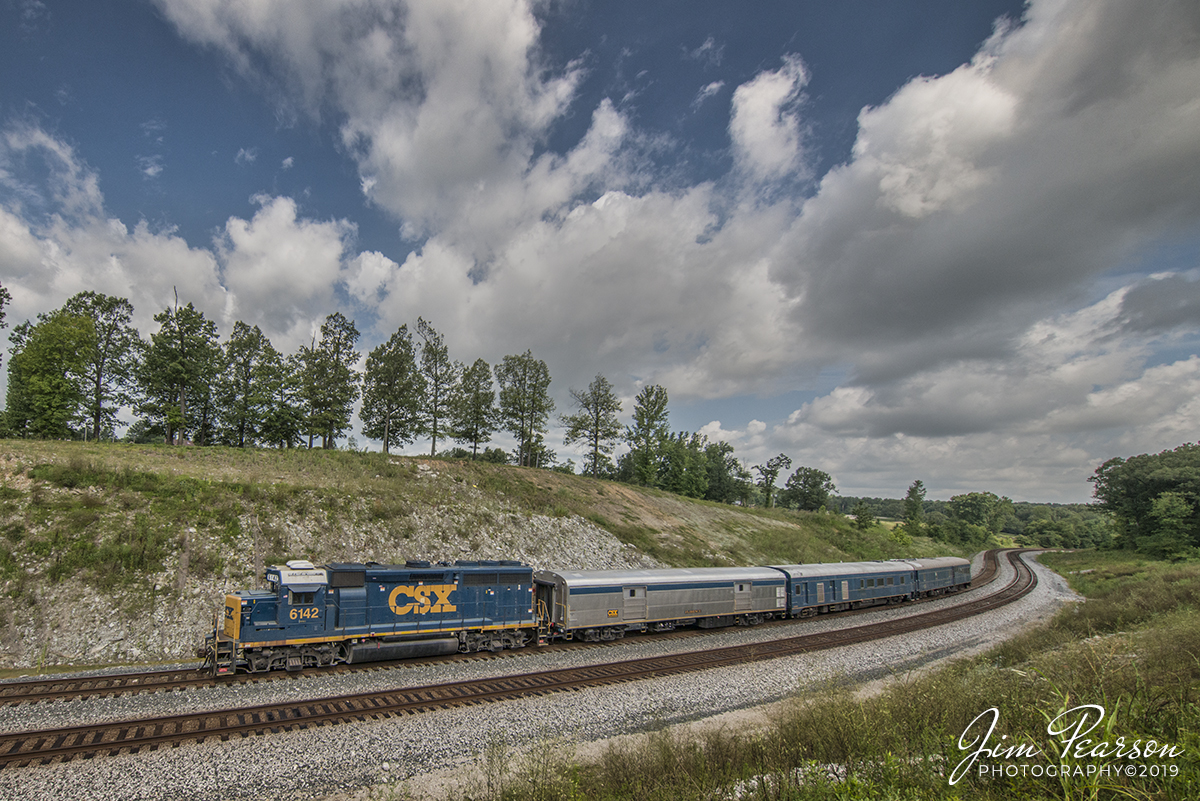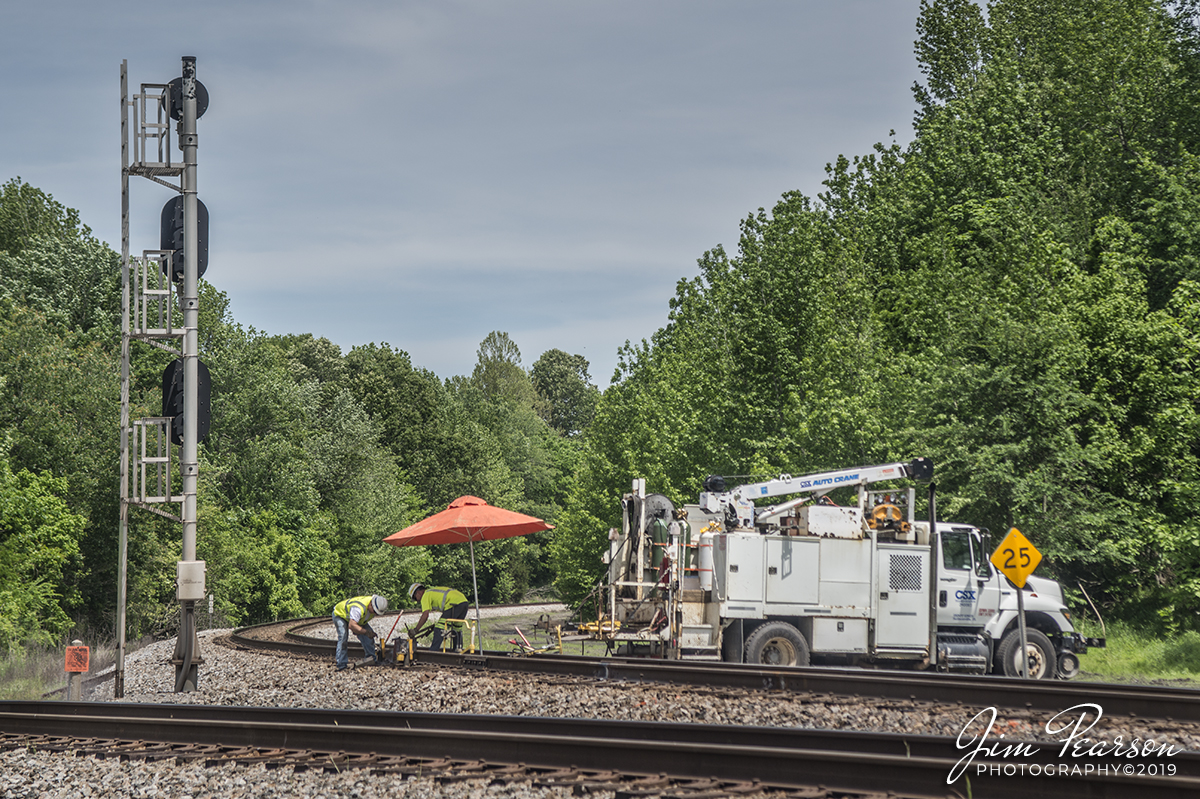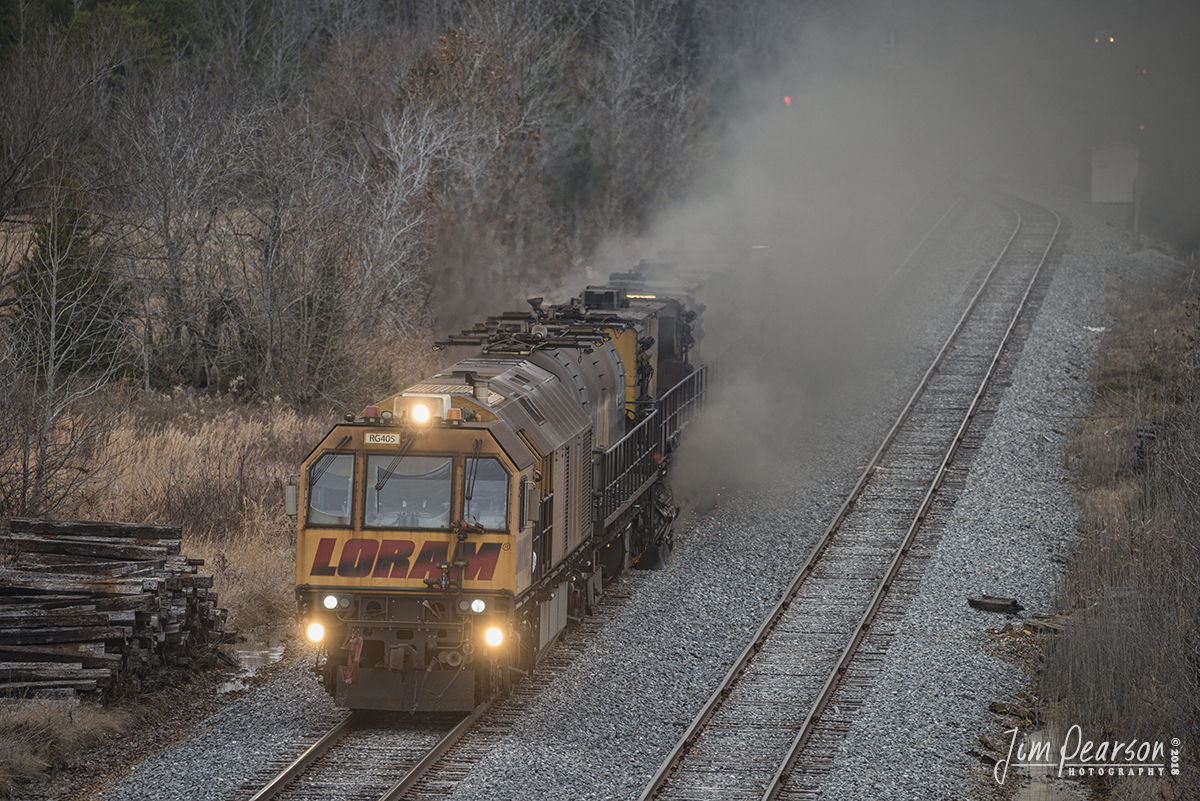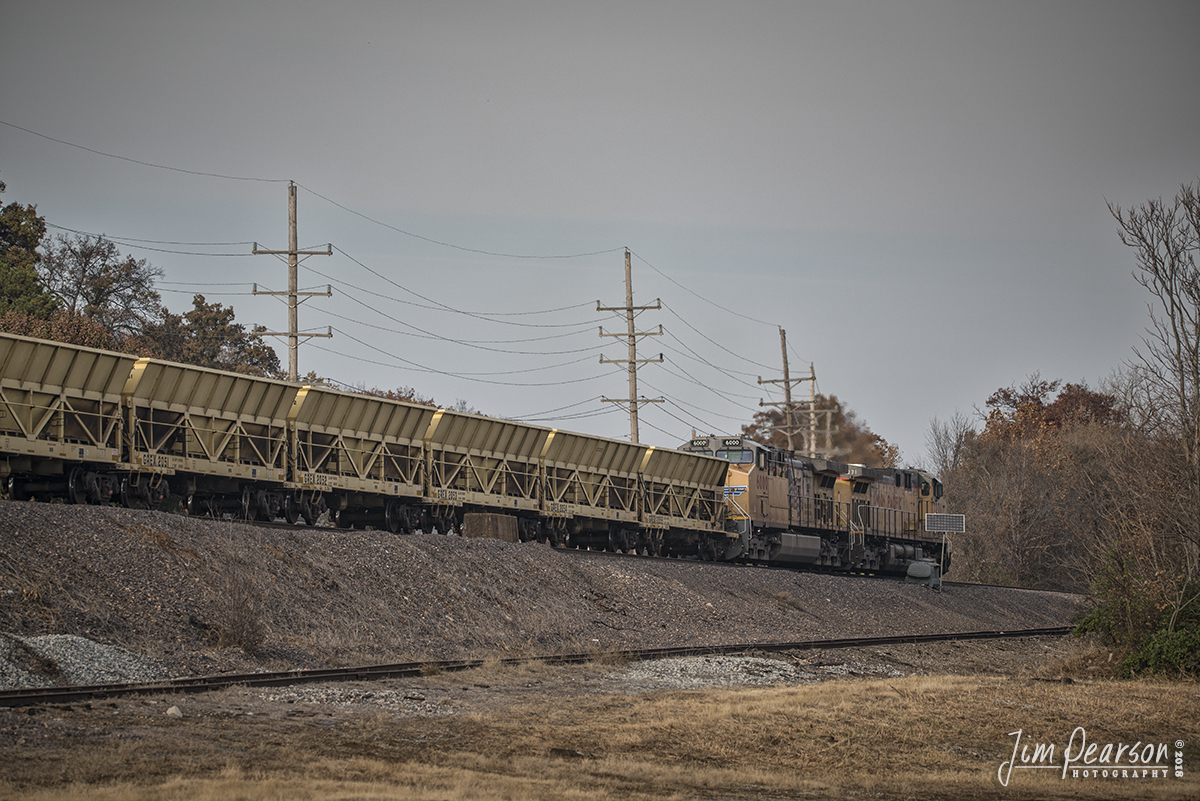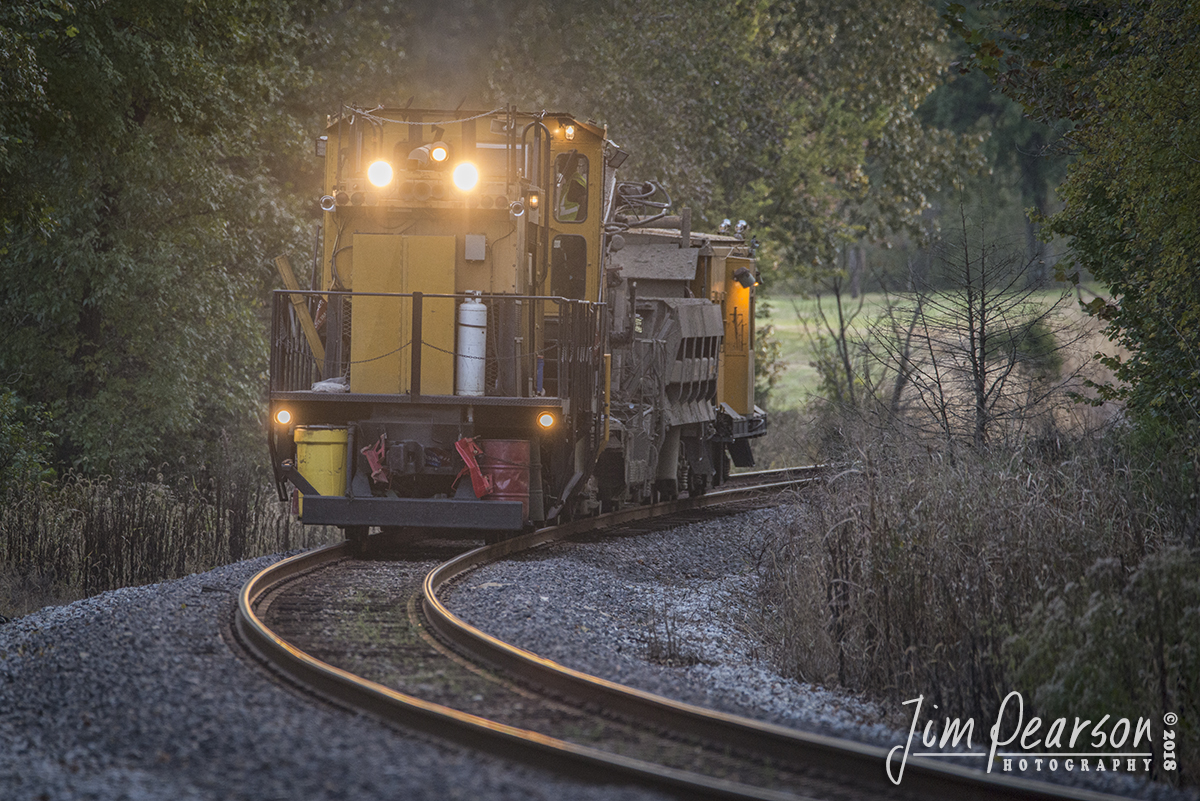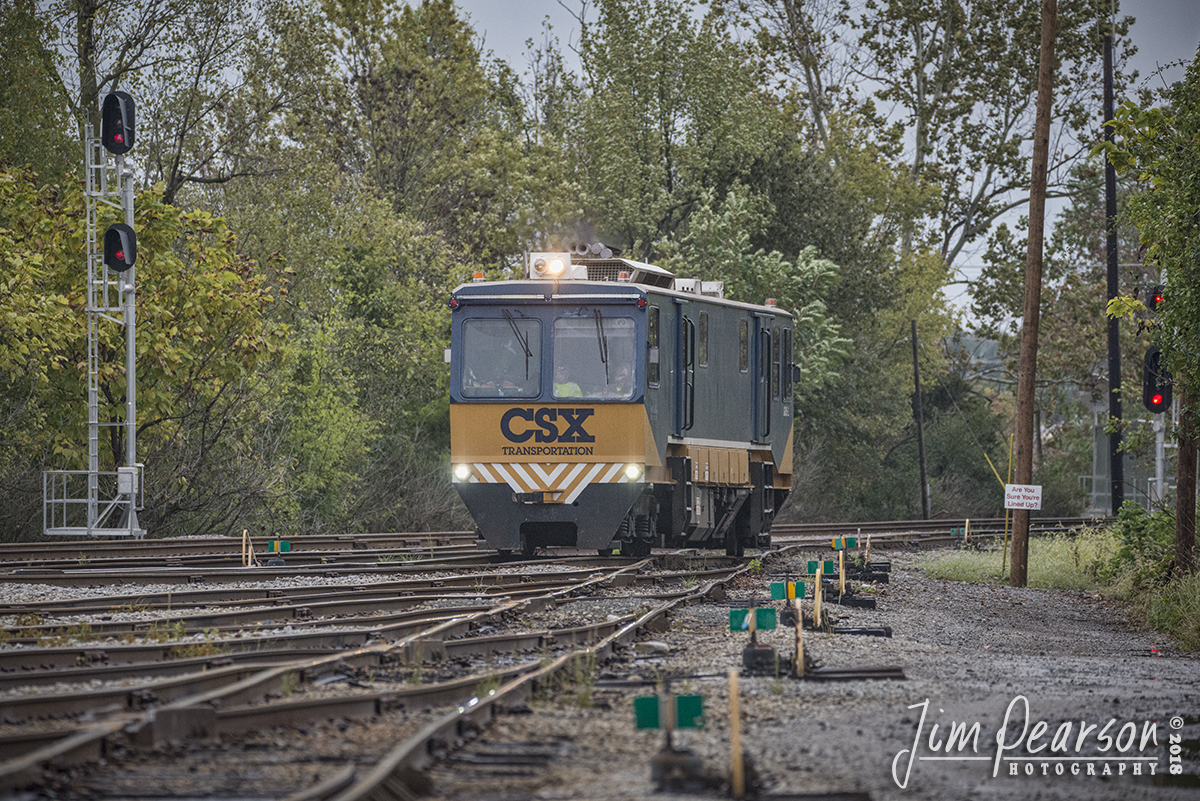August 8, 2009 – During one of my many trips over the years to Summer Rail I caught CSXT 154 & 395 as it led a maintenance of way train, with two switches in gondolas, as it crossed over the Ohio River at Covington, Kentucky as it headed south off the C&O Railroad bridge from Cincinnati, Ohio.
Geometry Inspection train W001-20 at Robards, Ky
April 20, 2020 – CSXT G213 passes CSXT 6025 heading up Geometry Inspection train W001-20 as they inspect track two, just south of Anaconda at Robards, Kentucky on the Henderson Subdivision.
On the rear of the trains is the actual track geometry car (also known as a track recording car) which is an automated track inspection vehicle.
It used to test several geometric parameters of the track without obstructing normal railroad operations. Some of the parameters generally measured include position, curvature, alignment of the track, smoothness, and the cross level of the two rails.
It uses a variety of sensors, measuring systems, and data management systems to create a profile of the track being inspected.
CSXT 380 leads empty coal train E013-13 NB at Romney…
April 14, 2020 – CSXT 380 leads empty coal train E013-13 as it passes a weed sprayer crew at CP Romney as it heads north on the Henderson Subdivision at Mannington, Ky.
A CSX High Railer leads a weed sprayer truck…
April 14, 2020 – A CSX High Railer leads a weed sprayer truck just past the highway 62 overpass on track 1, as it sprays the right-of-way at Nortonville, Ky, as the pair make their way south on the Henderson Subdivision, while performing their springtime work.
CSX as Q502 crosses over the Craborchard Creek bridge…
March 31, 2020 – A CSX bridge work crew keeps a watchful eye and sends a friendly wave to the crew of CSX as Q502 crosses over the Craborchard Creek bridge, as CSXT mobile crane 916100 sits idle, as the manifest heads north through their work zone on the Henderson Subdivision at Nortonville, Ky. The crane is an AMERICAN Model 840 Locomotive Crane with a pile driver attached.
The bridge crew is working on installing new pilings for the bridge over Craborchard Creek using the pile driver attached to the crane. I’ll be posting a video on the operation later today if you’re interested in seeing and hearing it work.
Here’s more information on the crane if you’re interested: http://aolcrane.com/pdfs/840850debrochure.pdf
CSX J052-25 pulling a loaded ballast train…
March 25, 2020 – CSXT 4016 runs long nose forward as it heads up CSX J052-25 pulling a loaded ballast train as it works it’s way south at CP Anaconda on the Henderson Subdivision at Robards, Ky.
Two Chicago Transit Authority (CTA) Track Inspectors…
February 20, 2020 – Two Chicago Transit Authority (CTA) Track Inspectors work their way along the maze of tracks at the intersection of the L at Tower 18 in downtown Chicago, Illinois. The safety of rail traffic everywhere falls on the maintenance of way crews as they inspect the miles of tracks in all kinds of weather!
CSXT 7916 leads loaded ballast train…
October 23, 2019 – CSXT 7916 leads loaded ballast train W089 as it pulls onto the Henderson Subdivision main from the siding at the north end of Latham in Hopkinsville, Kentucky as it continues its trip north.
SX W032-17, with CSXT 4062 a SD40-3 leading…
September 22, 2019 – CSX W032-17, with CSXT 4062 a SD40-3 leading, heads north at Sherwood, Tennessee on the Chattanooga Subdivision with a load of MOW equipment.
CSX W032-17, with CSXT 4062 a SD40-3 leading…
September 22, 2019 – CSX W032-17, with CSXT 4062 a SD40-3 leading, meets a northbound Q581 at Sherwood, Tennessee, as it heads north on the Chattanooga Subdivision with a load of MOW equipment.
CSX W032-17, with CSXT 4062 a SD40-3 leading…
September 22, 2019 – CSX W032-17, with CSXT 4062 a SD40-3 leading, passes the depot at Stevenson, Alabama as it heads north on the Chattanooga Subdivision with a load of MOW equipment.
According to Wikipedia: The Stevenson Railroad Depot and Hotel are a historic train station and hotel in Stevenson, Alabama. They were built circa 1872 as a joint project of the Memphis and Charleston Railroad and the Nashville and Chattanooga Railroad, whose lines converged in Stevenson. When the Memphis & Charleston was purchased by the Southern Railway in 1898, the Louisville and Nashville Railroad (who had taken over the N&C in 1880) took sole control of the depot and operated it until 1976.
It was converted into a history museum in 1982. Both buildings are brick with gable roofs and Italianate details. The depot has a central, second-story tower that was added in 1887. The three-story hotel had a lobby, dining room, and kitchen on the first floor and eight large guest rooms on the upper floors. The buildings were listed on the Alabama Register of Landmarks and Heritage in 1975 and the National Register of Historic Places in 1976.
The building is now operated as the Stevenson Railroad Depot Museum and features area railroad and Civil War artifacts
LoRam Badger Ditching machine, DC-2…
July 15, 2019 – LoRam Badger Ditching machine, DC-2, works along the power siding at the south end of CSX’s Atkinson Yard at Madisonville, Kentucky, as it works its way north on the Henderson Subdivision.
According to the Loram website: The Badger Ditcher is a self-propelled ditch cleaner that is capable of moving 1,000 tons of material every hour, excavating at up to 22 feet from the center of the track. The Loram ditch cleaner creates a properly sloped ditch that intercepts and diverts water away from the track. The ditchers high-speed, high-performance ditching wheel digs in and picks up mud and water. As the wheel digs the ditch, water begins to flow.
The Badger Ditcher helps manage, remedy and prevent the damaging effects from a host of penetrating water sources, including direct precipitation, groundwater migration, springs and trapped water, saturation and seepage. Ditch maintenance best practices using the Badger Ditcher lets railroads improve vital drainage for the subgrade, lower the water table, control run-off and promote free flow from the ballast section that can extend the effective duration of undercutting and ballast cleaning cycles.
CSX W001-03 Track Inspection Geometry Train…
July 3, 2019 – CSX W001-03 Track Inspection Geometry Train heads south on the Henderson Subdivision at Oak Hiil, between Nortonville, and Mortons Gap, Kentucky with the Florence, Columbus and a Track Geometry Car.
According to Wikipedia: A track geometry car (also known as a track recording car) is an automated track inspection vehicle on a rail transport system used to test several geometric parameters of the track without obstructing normal railroad operations.
Some of the parameters generally measured include position, curvature, alignment of the track, smoothness, and the crosslevel of the two rails. The cars use a variety of sensors, measuring systems, and data management systems to create a profile of the track being inspected.
CSX W001-03 Track Inspection Geometry Train…
July 3, 2019 – CSX W001-03 Track Inspection Geometry Train heads south on the Henderson Subdivision at Nortonville, Kentucky with the Florence, Columbus and a Track Geometry Car.
According to Wikipedia: A track geometry car (also known as a track recording car) is an automated track inspection vehicle on a rail transport system used to test several geometric parameters of the track without obstructing normal railroad operations. Some of the parameters generally measured include position, curvature, alignment of the track, smoothness, and the crosslevel of the two rails.
The cars use a variety of sensors, measuring systems, and data management systems to create a profile of the track being inspected.
Things don’t always go as planned, do they!!
May 8, 2019 – Things don’t always go as planned, do they!! Today I ended up with this nice shot showing two CSX Welders repairing a section of track on the cutoff at Mortons Junction on the Henderson Subdivision at Mortons Gap, Ky. Don’t get me wrong, I like the shot, but it’s not the one I planned.
Let me backup just a little. The bridge over the tracks at Nortonville, Ky has been out of service sincesince last year and they finally opened it back up so I decided to head there to do a live video of a southbound train going through the nice S curve there. After setting at the location for almost two hours with no traffic, other than a track inspector, I had to head back to Madisonville.
I passed through Mortons Gap to check the signal incase there was a northbound coming behind me when I found these two guys hard at work repairing a section of rail. I passed them by as I was running late to pick up one of my nieces from preschool and low and behold I encounter a southbound coal train at the next crossing on the main!
Well, I whip around and head back to the junction with just enough time to spare before the head end power on the train prepared to pass the workers! A good 24mm shot with the train trailing off and the workers waving to the crew as the train pulled into the sweet spot for the picture and I started shooting away… with no card in the camera!
It happens to all of us!! I thought sure I had put it back, but obviously not! Now, the card was in the car, so if I had stopped in the first place to photograph them working, I would have realized it and put the card in and probably got the shot I wanted! So for me the moral of this story is, don’t pass up a shot! If you see one and it catches your eye then it’s worth exploring! Plus, you might have time to stick a card in before your secondary subject arrives!
After doing this for over 40 years you’d think I’d learn a thing or two! Keep clicking folks and always make sure when you head out that there’s a card in your camera!! LOL
November 29, 2018 – LoRam Railgrinder 405 is surrounded with dust…
November 29, 2018 – LoRam Railgrinder 405 is surrounded with dust as it grinds just past the switch at the north end of the Dawson Springs, Siding, as it works south on the Paducah and Louisville Railway, at Dawson Springs, Ky. – #jimstrainphotos #kentuckyrailroads #trains #nikond800 #railroad #railroads #train #railways #railway #pal #railgrinder #loram
November 17, 2018 – A Union Pacific Railroad work train…
November 17, 2018 – A Union Pacific Railroad work train passes through Valley Park, MO with UP 7271 & 6000 leading, as it heads east toward Kirkwood, MO on the Jefferson City Subdivision. – #jimstrainphotos #missourirailroads #trains #nikond800 #railroad #railroads #train #railways #railway #up #uprailroad
October 24, 2018 – LoRam DC-2 Ditch Cleaner…
October 22, 2018 – CSX crews keep an eye on LoRam Ditch Cleaner…
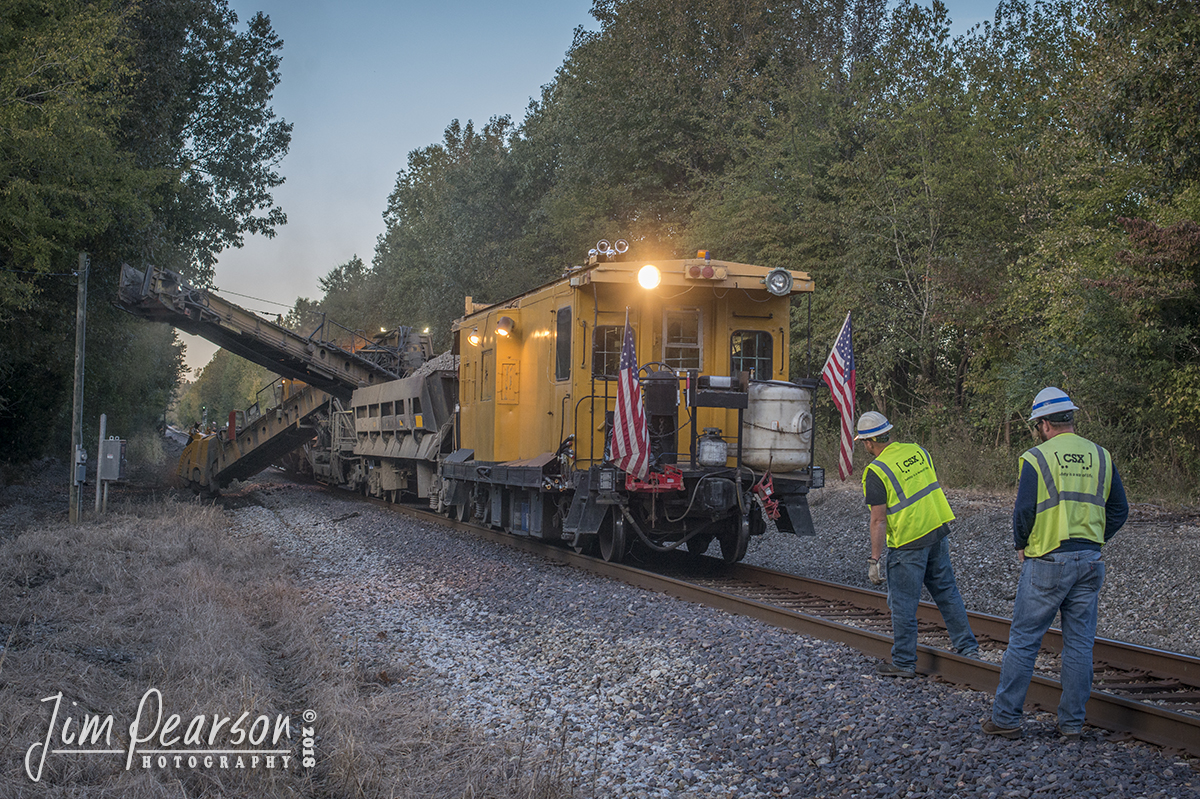
October 22, 2018 – CSX crews keep an eye on LoRam Ditch Cleaner (DC-2) as it works its way north on the Earlington Cutoff of the Henderson Subdivision at the Flat Creek Road Crossing in Mortons Gap, Ky.
According to LoRam’s Website: Ditch Cleaning Is essential for the longevity and foundational strength of a railway, proper ditch maintenance increases the stability of ballast and subgrade by moving water away from the track and right of way. Delivering substantial benefits and ROI, ditch cleaning increases cycle time between expensive surfacing and lining programs, prevents premature tie deterioration and ensures a long-lasting and stable track structure.
Lorams drainage maintenance solutions, including shoulder ballast cleaning, undercutting and ditch cleaning, work in concert to ensure that damaging water is intercepted and diverted from the track infrastructure.
Cleaned, maintained and properly-sloped ditches provide a host of benefits including: Facilitates vital drainage from the ballast section of the track, Manages the effects of penetrating water sources, Ensures the efficacy of track level drainage maintenance and Reduces or eliminates water-saturated track soils. – #jimstrainphotos #kentuckyrailroads #trains #nikond800 #railroad #railroads #train #railways #railway #csx #csxrailroad
October 15, 2018 – Well, they say third time is charm!!
October 15, 2018 – Well, they say third time is charm!! This is the third time I’ve seen this geometry car, CSX W002, GMS-2, in as many days, but today I was finally able to capture it with my camera! It’s been inspecting track on the Paducah and Louisville Railway (PAL), which I wasn’t in the position to chase or photograph. Today I caught it after it left the PAL at East Diamond and came back onto the south end of CSX’s Atkinson Yard in Madisonville, Ky on the Henderson Subdivision where it tied down.
According to Wikipedia, A track geometry car (also known as a track recording car) is an automated track inspection vehicle on a rail transport system used to test several geometric parameters of the track without obstructing normal railroad operations. Some of the parameters generally measured include position, curvature, alignment of the track, smoothness, and the cross level of the two rails. The cars use a variety of sensors, measuring systems, and data management systems to create a profile of the track being inspected.
Track geometry cars emerged in the 1920s when rail traffic became sufficiently dense that manual and visual inspections were no longer practical. Furthermore, the increased operating speeds of trains of that era required more meticulous maintained tracks. In 1925, the Chemins de fer de l’Est put a track geometry car into operation carrying an accelerograph developed by Emile Hallade, the inventor of the Hallade Method. The accelerograph could record horizontal and vertical movement as well as roll. It was fitted with a manual button to record milestones and stations in the record. Such car was developed by travaux Strasbourg now part of GEISMAR Group. By 1927 the Atchison, Topeka and Santa Fe Railway had a track car in operation followed by the Estrada de Ferro Central do Brasil in 1929. These two cars were built by Baldwin using the gyroscope technology of Sperry Corporation.
The first track geometry car in Germany appeared in 1929 and was operated by Deutsche Reichsbahn. The equipment for this car came from Anschütz in Kiel, a company currently owned by Raytheon. In Switzerland, the first track geometry recording equipment was integrated in an already existing dynamometer car in 1930.
One of the earliest track geometry cars was Car T2 used by the U.S. Department of Transportation’s Project HISTEP (High-Speed Train Evaluation Program). It was built by the Budd Company especially for Project HISTEP to evaluate track conditions between Trenton and New Brunswick, NJ, where the DOT had established a section of track for testing high-speed trains, and accordingly, the T2 ran at speeds of 150 miles per hour or faster.
Many of the first regular service geometry cars were created from old passenger cars outfitted with the appropriate sensors, instruments, and recording equipment, coupled behind a locomotive. By at least 1977, self-propelled geometry cars had emerged. Southern Pacific’s GC-1 (built by Plasser American) was among the first and utilized twelve measuring wheels in conjunction with strain gauges, computers, and spreadsheets to give managers a clear picture of the condition of the railroad. Even in 1981, the Encyclopedia of North American Railroads considered this the most advanced track geometry car in North America. – #jimstrainphotos #kentuckyrailroads #trains #fujixt1 #railroad #railroads #train #railways #railway #csx #csxrailroad
September 2, 2018 – Chicago Transit Authority MOW workers…
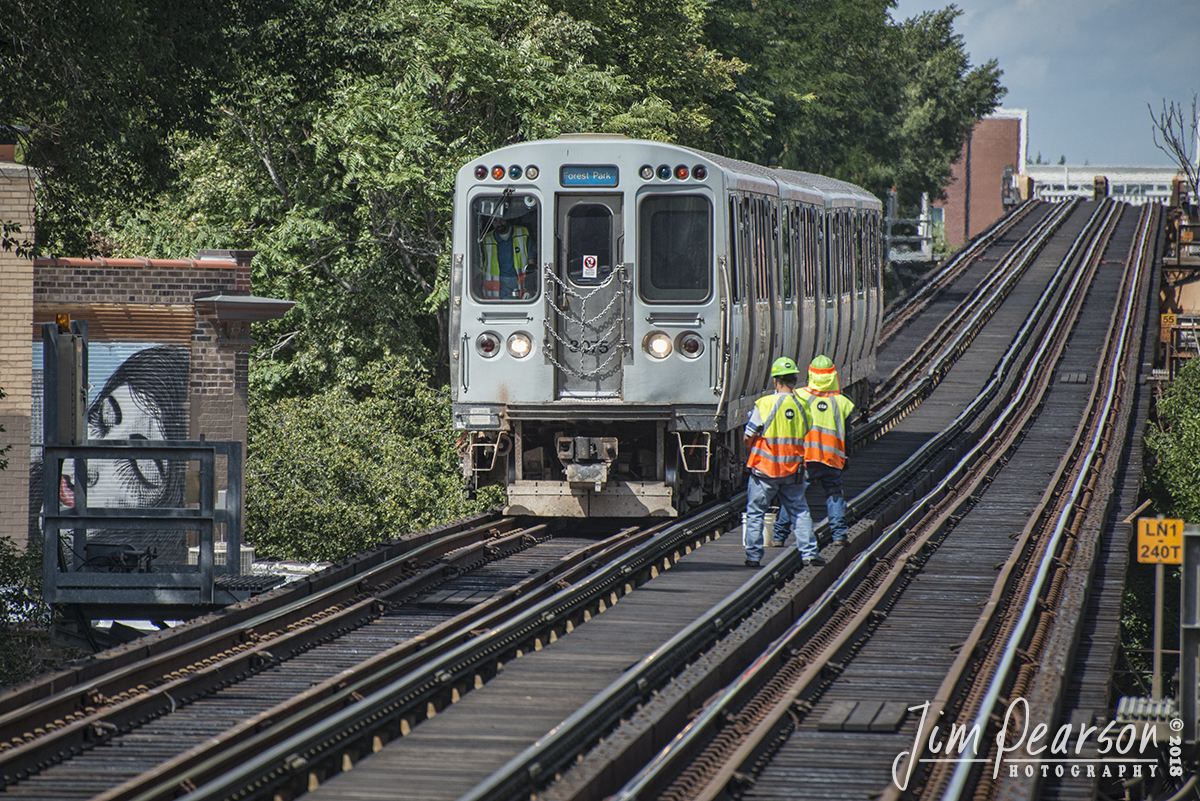
September 2, 2018 – Chicago Transit Authority MOW workers and the engineer on a Blue Line train to Forest Park keep a close eye on each other as the train makes its way past them just outside the Damen Street Station in Chicago, Illinois. – #jimstrainphotos #illinoisrailroads #trains #nikond800 #railroad #railroads #train #railways #railway #cta #thechicagol #chicago

